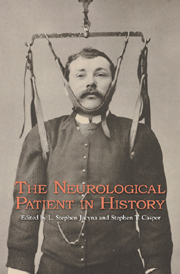Book contents
- Frontmatter
- Contents
- Preface
- Acknowledgments
- Introduction
- Part One Medicine Constructs the “Neurological Patient”
- Part Two Public and Private Constructions of the “Neurological Patient”
- Part Three Patient Groups Construct the “Neurological Patient”
- Part Four The Patient Constructs the “Neurological Patient”
- Part Five Historians Construct the “Neurological Patient”
- Bibliography
- List of Contributors
- Index
Introduction
Published online by Cambridge University Press: 12 September 2012
- Frontmatter
- Contents
- Preface
- Acknowledgments
- Introduction
- Part One Medicine Constructs the “Neurological Patient”
- Part Two Public and Private Constructions of the “Neurological Patient”
- Part Three Patient Groups Construct the “Neurological Patient”
- Part Four The Patient Constructs the “Neurological Patient”
- Part Five Historians Construct the “Neurological Patient”
- Bibliography
- List of Contributors
- Index
Summary
The essays in this volume deal with the construction of the “neurological patient” as a category in Western medicine. They therefore touch upon how doctors have constructed categories of nervous disease over the past two centuries, and on how medicine has viewed and treated those it has diagnosed as suffering from these complaints. This volume is therefore concerned with one particular version of the clinical gaze. These essays proceed from the premise that neurological disease is not an essence waiting to be discovered but rather a construct with a discernible historicity. But this collection is also concerned with the experience of nervous disease: with what it was to be a neurological patient. One major contention appearing throughout these contributions is that the neurological patient cannot be viewed from a purely clinical perspective. The experience of nervous disease can affect all aspects of an individual's persona, and can permeate the social nexus within which he or she lives. In this respect the neurological patient shares much in common with those who suffer from other kinds of illness. But neurological disease has a peculiar capacity to strike at the core of what in Western culture is taken to constitute personal identity, social status, and competence-indeed even what it is to be human.
“The Patient” in Medical History
For much of the twentieth century historians of medicine were chiefly concerned with changes in medical knowledge, discoveries, and hagiography. From the 1960s onward, however, a generation of social historians of medicine who had been inspired by new trends in sociology, philosophy of science, and general history began to gravitate toward topics that would come to dominate the new historiography of medicine, namely, the professions of medicine, the institutions of medicine, and the social transformations wrought by endemic and epidemic diseases in modern society.
- Type
- Chapter
- Information
- The Neurological Patient in History , pp. 1 - 18Publisher: Boydell & BrewerPrint publication year: 2012



